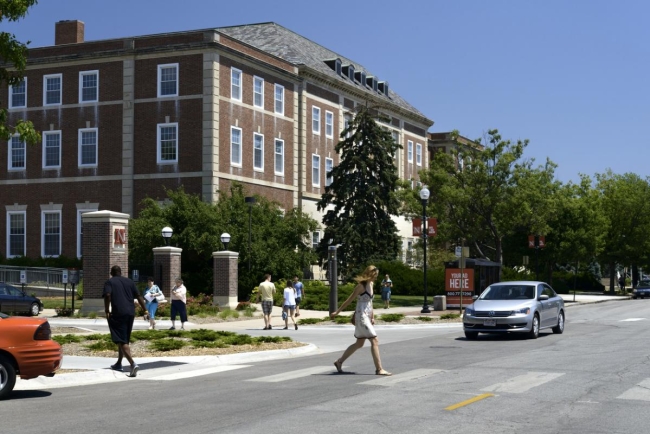You have /5 articles left.
Sign up for a free account or log in.

University of Nebraska at Lincoln
istock.com/RiverNorthPhotography
The pandemic has caused many students to hit pause on their education while colleges work to determine whether they can reopen for in-person instruction this fall.
Uncertain enrollments and potentially high summer melt have driven colleges to announce a variety of tuition discounts and scholarship programs to entice prospective students and to keep those already enrolled. Whether the programs will pay off is still to be determined.
The University of Nebraska system debuted its Nebraska Promise program in April. It had been in the works for a while, said President Ted Carter, but the timing of the announcement was driven by the pandemic.
The program offers to waive tuition and fees for resident Nebraska students who are Pell Grant eligible or whose families make less than $60,000 a year -- equating to about 1,000 additional students, Carter said. Students are responsible for room and board fees.
Delaying the program was “something we could not afford to do,” Carter said. The system will also implement a two-year tuition freeze.
Without it, Carter worried the university would face a 10 to 15 percent enrollment drop. “It would take us 10 years to recover that,” he said.
Applications were down 5.4 percent in April before the program was announced. Since, application numbers have grown by 15.8 percent in just over a month -- an increase of 1,900 applications as of May 22. Compared with last year’s numbers, applications are up by 4.7 percent.
“We have swung the pendulum the other way,” said Melissa Lee, a university spokesperson.
Albion College, a small, private, four-year college in Albion, Mich., announced a similar program in late April. The Michigan 2020 Promise program will cover tuition and fees for in-state students whose families make less than $65,000 a year and provide students whose families make more than $65,000 at minimum $92,000 in scholarships across four years. The program is open to high school seniors and transfer students.
“It’s for students who were thinking of going to the East or West Coast and decided they wanted to stay closer to home. It’s for students who are thinking of going to an institution with 40,000 students and decided they would feel more comfortable in a rural community and a college of 1,500 students,” said Mauri Ditzler, Albion's president.
The college has so far received an additional 250 applications, and at a typical 20 percent yield, that would translate to about 50 more enrolled students, Ditzler said.
It’s still to be determined whether the promise programs actually translate to enrolled students. Colleges are worried about summer melt -- which experts say could be much higher this year due to the pandemic.
The University of Nebraska and Albion College are in good company. Ohio Wesleyan University canceled its planned 3 percent tuition increase. Maricopa County Community College District’s board recently heard nine plans to reduce tuition rates for the fall semester. In Georgia, Thomas University is offering a 30 percent tuition discount to people who are seeking education after losing jobs or hours during the pandemic. The list of colleges offering discounts and tuition freezes goes on.
Donald Heller, vice president for operations and former provost at the University of San Francisco, said this is the first time he’s seen colleges enact so many tuition deal programs.
“The concern about enrollments this fall is unprecedented, at least in my lifetime,” Heller said. “For the recession in 2008, people expected, if there was going to be an impact, for it to be much more gradual than the kind of projections that we’re seeing for this fall.”
The financial payoff of full tuition scholarships is also up in the air. At Albion, a donor is underwriting the program, and part of its cost will come out of the existing financial aid budget.
“Financial aid packages for those students are going to be … about $1 million per year,” Ditzler said. “Private institutions assume that almost every student is going to get some financial aid. So that’s not a net loss of $1 million per year that we could have gotten.”
Facing likely cuts to state funding, the University of Nebraska decided not to ask the state Legislature to offset the program.
“We knew we were going to be reassessing our overall budget program because of our revenue losses already -- we’re somewhere between $50 and $60 million in lost revenues between sports, housing, events on campus all the way through the summer,” Carter said.
Instead, the university is relying on budget reshuffling and some philanthropic help. The exact details of how to pay for the program are still being determined.
Heller noted that tuition isn’t the only revenue stream students bring.
“Most of the [programs] that I’ve seen are talking about tuition alone, so if a student comes in and is staying in a residence hall and buying a board plan, then there’s additional revenue going to the institution from that,” he said.
The University of Maine system also unveiled a special tuition discount program earlier this spring. From this year forward, the system is offering in-state tuition rates to any student whose college closed as a result of the pandemic and is looking to continue their studies elsewhere. The system would not share its list of potential college closures but noted that Pine Manor College -- a small Boston-area college that recently announced it would merge with Boston College -- was on the list. This program is similar to a plan the system has had for colleges in the Northeast.
"In the last five years, about 500,000 students found themselves in that situation," said Maine system chancellor Dannel Malloy. "This year it’s down, but my hunch is on a longer-term basis, it’s probably going to be going up."








